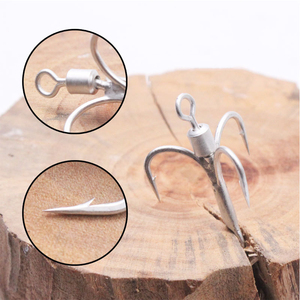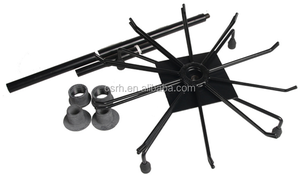(22509 products available)



























































































































































































































A rotating hook is a linkage component. It attaches two parts of a machine to allow relative movement. The hook's primary purpose is to permit one part to swing or rotate. It does so about a fixed point or another part. Rotating hooks are essential in machines. They also come in handy in structures that need controlled movement and stability. For example, rotating hooks are used in cranes. They help lift and lower heavy loads. They also help move them from one place to another. They are used in vehicles to connect the wheels to the axles. They enable the wheels to rotate independently. They are also used in robots to allow the arms to move and manipulate objects. The hook is designed to enhance the functionality of a machine. It improves the performance and efficiency of the system it is used in.
Rotating hooks come in various designs and sizes. Each is tailored for a specific application. Some common types include crane rotating hooks, clothes hook stands, and industrial rotating tool hooks. Each type of rotating hook has its unique features and advantages. It makes it suitable for its application. For instance, a crane hook is designed to lift heavy loads safely. It does so while a tool hook organizes tools to save space and improve efficiency. Understanding the different types of rotating hooks is essential. It helps one appreciate their significance in various industries. It also helps one understand their importance in daily life. Each type is designed to meet specific needs. It has features and advantages that make it suitable for its application. Whether it is a crane hook lifting a heavy load or a clothes hook stand holding garments in a store. Rotating hooks are used everywhere.
Rotating hooks are diverse. They range from industrial tools to home & garden applications. They are designed to improve efficiency and space utilization. Each type of hook serves a specific purpose. It helps organize and access tools and equipment. Some common types of rotating hooks include:
Industrial rotating tool hooks
Industrial rotating tool hooks are heavy-duty accessories. They are used in workshops and garages to hold tools like hammers, pliers, and wrenches. The hooks can rotate 360 degrees. They allow for easy access to the tools from any angle. Some models have a locking mechanism. It keeps the tools secure when not in use. These hooks help keep the workspace neat and organized. They also reduce the risk of accidents caused by scattered tools.
Rotating tool storage racks
These are rotating storage solutions for keeping tools and other items. They can have several hooks mounted on a central post. The post can spin. The hooks are used to hang items like bags, jackets, and more. Some rotating racks allow users to adjust the height of the hooks. They can accommodate items of different lengths. These hooks are great for workshops, kitchens, and closets.
Clothes hook stand
The rotating clothes hook stand is a portable accessory. It is used to hang clothes in homes, offices, and stores. The stand usually has several hooks arranged in a circular or spiral pattern. The hooks can rotate to allow users to access clothes from any angle. Some clothes hook stands have adjustable hooks. They can accommodate different types of garments, from coats to dresses.
Curtain rod rotating hooks
These hooks are used to hang curtains on a rotating curtain rod. They slide along the rod and twist as the rod is turned. They help open and close the curtains smoothly. They come in different designs. Some are plain while others are ornate. They add to the beauty of a room. They also make it easier to control the amount of light and privacy in the room.
Rotating plant pot hook
The plant pot hook is an innovative accessory. It is used to display plants in homes and offices. The rotating hook allows users to turn the plant pot. They can see it from different angles. It also adds a decorative touch to the interior. Some plant pot hooks have a swivel base. They can rotate the whole pot stand. They are great for showcasing plants.
Rotating hooks come in many shapes and sizes, each with its unique design features.
Ceiling rotating hooks
Ceiling hooks are made of solid materials like metal or durable plastic. They are designed with a central pivot mechanism that allows the hook part to spin or revolve. This pivot mechanism can be a simple bearing system or a more complex roller bearing system for smoother, easier rotation. Some ceiling hooks may have a locking mechanism to keep the hook in a fixed position until it is released. These hooks can support various items, such as plants, tools, and decorative objects.
Rotating coat hook
Rotating coat hooks are usually made of metal or high-quality plastic. The hook part may have a curved or angled shape to hold coats and bags conveniently. The rotating mechanism can be a simple screw or a complex set of gears, allowing the hook to turn smoothly. Some coat hooks are designed with multiple hooks that spread out when rotated, providing more space for hanging items. These hooks often have a sturdy base that can be mounted on walls or attached to doors.
Rotating tool hook
Tool hooks are usually made of strong materials like steel to support the weight of heavy tools. The design often includes a rubber or plastic coating on the hook surface to prevent tools from slipping off. The rotating mechanism can be a simple pin or a complex gear system, depending on the hook's size and intended use. Some tool hooks are designed with a locking mechanism to keep the tool secure while stored. These hooks can be attached to tool belts, storage racks, or workbenches.
Rotating garment hook
Garment hooks are typically made of materials like plastic or metal. They are designed with a smooth, rounded hook surface to prevent damage to garments. The rotating mechanism can be a simple pivot or a more complex gear system, allowing for easy access to clothes. Some garment hooks may have a locking mechanism to keep the hook in a fixed position. These hooks are often used in retail stores, showrooms, and personal closets.
The scenarios and applications of rotating hooks are many, and they go from the house to the industrial sector. In the home, garment racks can be fitted with rotating hooks. These allow easy access to clothes, and they can be used in kitchens to hang pans, or in bathrooms to hang towels. Moreover, they are used in workshops for tools and in garages to hang equipment and car tools. They maximize space and enable easy retrieval of items.
In the retail industry, clothing shops can use rotating hooks on racks to display garments. These hooks allow customers to access and view the items on sale. Moreover, rotating hooks are widely used in restaurants and catering services. They can be used to hang and rotate trays of food. This makes it easy for waiters to serve customers. Additionally, rotating hook racks for plants are available in gardens and nurseries. They allow gardeners to access the plants and create an attractive display.
In the aerospace and automotive industries, the use of rotating hooks is common. They are used to hang and organize tools, equipment, and parts on the production floor. Furthermore, the rotating hooks find their applications in warehousing and logistics. They are used to hang and transport bags and boxes. The rotating feature of the hook provides easy access to the contents. Additionally, rotating hooks can be found in the fishing industry. They are used to hang and organize fishing gears such as rods, baits, and tackles.
When choosing a suitable rotating hook, certain factors should be considered to ensure an optimal fit for the intended application. It is important to consider the weight capacity and specifications of the rotating hook. The hook's load rating should be sufficient for the intended purpose, and its dimensions should match the size requirements. Additionally, matching the materials used in construction is essential, as hooks are commonly made from materials like steel, stainless steel, or plastic, which offer different advantages in terms of corrosion resistance and durability.
Another point to consider is the presence of features such as a rotation mechanism, ease of installation, and any safety features like locking mechanisms. The rotation mechanism is crucial and can be in the form of ball bearings, swivel mechanisms, or rotating sections. Ease of installation is also vital and should be done through the available mounting hardware and instructions. Finally, it is essential to ensure that the hook is compatible with the systems or structures it will be used with.
Q1: How much weight can a rotating coat hook hold?
A1: Generally, each hook can hold 3-5 pounds. However, try to distribute the weight evenly among the hooks for maximum efficiency.
Q2: How can one prevent clothes from falling off the hooks?
A2: Use a rotating hook that has a non-slippery finish or a hook with a removable, non-slippery cover. One may also use hangers to keep garments on the hooks.
Q3: How can one install a rotating hook?
A3: First, mark the position on the wall. Next, drill holes and fix the base plate using screws. Finally, attach the hook mechanism to the base plate.
Q4: How can one maintain a rotating hook?
A4: Clean the hook regularly to remove dust and debris. Also, periodically check the screws and tightness of the hook rotation mechanism and adjust them if necessary.
Q5: What are the applications of rotating hooks?
A5: Rotating hooks are used in garments and accessories stores, hotels, and restaurants, and onboard cruise ships. They can also be used in households to maximize space in closets and entryways.